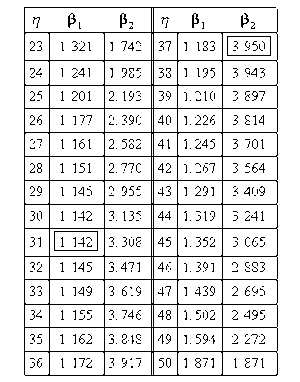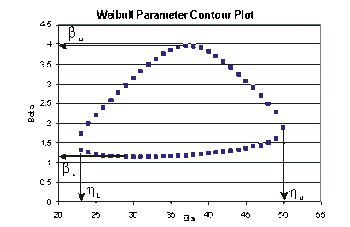Template:Example: Likelihood Ratio Bounds on Parameters: Difference between revisions
(Created page with ''''Likelihood Ratio Bounds on Parameters''' Five units were put on a reliability test and experienced failures at 10, 20, 30, 40, and 50 hours. Assuming a Weibull distribution, …') |
Kate Racaza (talk | contribs) No edit summary |
||
| Line 1: | Line 1: | ||
'''Likelihood Ratio Bounds on Parameters''' | '''Likelihood Ratio Bounds on Parameters''' | ||
Five units were put on a reliability test and experienced failures at 10, 20, 30, 40 | Five units were put on a reliability test and experienced failures at 10, 20, 30, 40 and 50 hours. Assuming a Weibull distribution, the MLE parameter estimates are calculated to be <math>\widehat{\beta }=2.2938</math> and <math>\widehat{\eta }=33.9428.</math> Calculate the 90% two-sided confidence bounds on these parameters using the likelihood ratio method. | ||
<br>'''Solution''' | |||
The first step is to calculate the likelihood function for the parameter estimates: | |||
The first step is to calculate the likelihood function | |||
::<math>\begin{align} | ::<math>\begin{align} | ||
| Line 16: | Line 15: | ||
\end{align}</math> | \end{align}</math> | ||
<br> | <br>where <span class="texhtml">''x''<sub>''i''</sub></span> are the original time-to-failure data points. We can now rearrange the likelihood ratio equation to the form: | ||
where < | |||
<br> | <br> | ||
::<math>L(\beta ,\eta )-L(\widehat{\beta },\widehat{\eta })\cdot {{e}^{\tfrac{-\chi _{\alpha ;1}^{2}}{2}}}=0</math> | |||
Since our specified confidence level, < | <br>Since our specified confidence level, <span class="texhtml">δ</span>, is 90%, we can calculate the value of the chi-squared statistic, <math>\chi _{0.9;1}^{2}=2.705543.</math> We then substitute this information into the equation: | ||
::<math>\begin{align} | ::<math>\begin{align} | ||
L(\beta ,\eta )-L(\widehat{\beta },\widehat{\eta })\cdot {{e}^{\tfrac{-\chi _{\ | L(\beta ,\eta )-L(\widehat{\beta },\widehat{\eta })\cdot {{e}^{\tfrac{-\chi _{\alpha ;1}^{2}}{2}}}= & 0 \\ | ||
\\ | \\ | ||
L(\beta ,\eta )-1.714714\times {{10}^{-9}}\cdot {{e}^{\tfrac{-2.705543}{2}}}= & 0 \\ | L(\beta ,\eta )-1.714714\times {{10}^{-9}}\cdot {{e}^{\tfrac{-2.705543}{2}}}= & 0 \\ | ||
| Line 33: | Line 31: | ||
\end{align}</math> | \end{align}</math> | ||
<br>The next step is to find the set of values of <span class="texhtml">β</span> and <span class="texhtml">η</span> that satisfy this equation, or find the values of <span class="texhtml">β</span> and <span class="texhtml">η</span> such that <math>L(\beta ,\eta )=4.432926\cdot {{10}^{-10}}.</math> | |||
The solution is an iterative process that requires setting the value of <span class="texhtml">β</span> and finding the appropriate values of <span class="texhtml">η</span>, and vice versa. The following table gives values of <span class="texhtml">β</span> based on given values of <span class="texhtml">η</span>. | |||
The solution is an iterative process that requires setting the value of < | |||
[[Image: | <br>[[Image:Confidencechart1.gif|thumb|center|300px]] | ||
<br>These data are represented graphically in the following contour plot: | |||
<br>[[Image:Weibullparametercontourplot.gif|thumb|center|350px]] | |||
<br>(Note that this plot is generated with degrees of freedom <span class="texhtml">''k'' = 1</span>, as we are only determining bounds on one parameter. The contour plots generated in Weibull++ are done with degrees of freedom <span class="texhtml">''k'' = 2</span>, for use in comparing both parameters simultaneously.) As can be determined from the table, the lowest calculated value for <span class="texhtml">β</span> is 1.142, while the highest is 3.950. These represent the two-sided 90% confidence limits on this parameter. Since solutions for the equation do not exist for values of <span class="texhtml">η</span> below 23 or above 50, these can be considered the 90% confidence limits for this parameter. In order to obtain more accurate values for the confidence limits on <span class="texhtml">η</span>, we can perform the same procedure as before, but finding the two values of <span class="texhtml">η</span> that correspond with a given value of <span class="texhtml">β.</span> Using this method, we find that the 90% confidence limits on <span class="texhtml">η</span> are 22.474 and 49.967, which are close to the initial estimates of 23 and 50. | |||
Note that the points where < | <br>Note that the points where <span class="texhtml">β</span> are maximized and minimized do not necessarily correspond with the points where <span class="texhtml">η</span> are maximized and minimized. This is due to the fact that the contour plot is not symmetrical, so that the parameters will have their extremes at different points. | ||
Revision as of 18:33, 8 March 2012
Likelihood Ratio Bounds on Parameters
Five units were put on a reliability test and experienced failures at 10, 20, 30, 40 and 50 hours. Assuming a Weibull distribution, the MLE parameter estimates are calculated to be [math]\displaystyle{ \widehat{\beta }=2.2938 }[/math] and [math]\displaystyle{ \widehat{\eta }=33.9428. }[/math] Calculate the 90% two-sided confidence bounds on these parameters using the likelihood ratio method.
Solution
The first step is to calculate the likelihood function for the parameter estimates:
- [math]\displaystyle{ \begin{align} L(\widehat{\beta },\widehat{\eta })= & \underset{i=1}{\overset{N}{\mathop \prod }}\,f({{x}_{i}};\widehat{\beta },\widehat{\eta })=\underset{i=1}{\overset{5}{\mathop \prod }}\,\frac{\widehat{\beta }}{\widehat{\eta }}\cdot {{\left( \frac{{{x}_{i}}}{\widehat{\eta }} \right)}^{\widehat{\beta }-1}}\cdot {{e}^{-{{\left( \tfrac{{{x}_{i}}}{\widehat{\eta }} \right)}^{\widehat{\beta }}}}} \\ \\ L(\widehat{\beta },\widehat{\eta })= & \underset{i=1}{\overset{5}{\mathop \prod }}\,\frac{2.2938}{33.9428}\cdot {{\left( \frac{{{x}_{i}}}{33.9428} \right)}^{1.2938}}\cdot {{e}^{-{{\left( \tfrac{{{x}_{i}}}{33.9428} \right)}^{2.2938}}}} \\ \\ L(\widehat{\beta },\widehat{\eta })= & 1.714714\times {{10}^{-9}} \end{align} }[/math]
where xi are the original time-to-failure data points. We can now rearrange the likelihood ratio equation to the form:
- [math]\displaystyle{ L(\beta ,\eta )-L(\widehat{\beta },\widehat{\eta })\cdot {{e}^{\tfrac{-\chi _{\alpha ;1}^{2}}{2}}}=0 }[/math]
Since our specified confidence level, δ, is 90%, we can calculate the value of the chi-squared statistic, [math]\displaystyle{ \chi _{0.9;1}^{2}=2.705543. }[/math] We then substitute this information into the equation:
- [math]\displaystyle{ \begin{align} L(\beta ,\eta )-L(\widehat{\beta },\widehat{\eta })\cdot {{e}^{\tfrac{-\chi _{\alpha ;1}^{2}}{2}}}= & 0 \\ \\ L(\beta ,\eta )-1.714714\times {{10}^{-9}}\cdot {{e}^{\tfrac{-2.705543}{2}}}= & 0 \\ \\ L(\beta ,\eta )-4.432926\cdot {{10}^{-10}}= & 0 \end{align} }[/math]
The next step is to find the set of values of β and η that satisfy this equation, or find the values of β and η such that [math]\displaystyle{ L(\beta ,\eta )=4.432926\cdot {{10}^{-10}}. }[/math]
The solution is an iterative process that requires setting the value of β and finding the appropriate values of η, and vice versa. The following table gives values of β based on given values of η.
These data are represented graphically in the following contour plot:
(Note that this plot is generated with degrees of freedom k = 1, as we are only determining bounds on one parameter. The contour plots generated in Weibull++ are done with degrees of freedom k = 2, for use in comparing both parameters simultaneously.) As can be determined from the table, the lowest calculated value for β is 1.142, while the highest is 3.950. These represent the two-sided 90% confidence limits on this parameter. Since solutions for the equation do not exist for values of η below 23 or above 50, these can be considered the 90% confidence limits for this parameter. In order to obtain more accurate values for the confidence limits on η, we can perform the same procedure as before, but finding the two values of η that correspond with a given value of β. Using this method, we find that the 90% confidence limits on η are 22.474 and 49.967, which are close to the initial estimates of 23 and 50.
Note that the points where β are maximized and minimized do not necessarily correspond with the points where η are maximized and minimized. This is due to the fact that the contour plot is not symmetrical, so that the parameters will have their extremes at different points.

